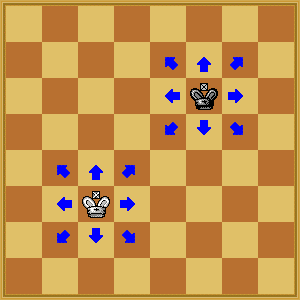

It is typically leveraged as a response to 1.d4. It consists of a hypermodern opening, wherein the Black intentionally allows the White control of the center of the board with its pawns so that the Black can subsequently challenge the White. Once in the game, each king is allowed to make a special double move, to Rook (chess) - Wikipedia. The King’s Indian Defense is a famous chess opening move. The King or Rook after Castling would be exposed to capture. The king can move only one square horizontally, vertically, or diagonally. Barden, Leonard (1980), Play better chess with Leonard Barden, Octopus Books Limited, pp. The King or Rook has already made a move, 3.(1977), An illustrated dictionary of chess, Hamlyn Publishing Group, p. 151, ISBN 1-55521-394-4 In the endgame, however, the king may comes out of hiding to play an active role as an offensive piece as well as helping in the promotion of their remaining pawns. Instead, a player will usually castle and find safety on the edge of the board behind pawns. In the opening and middlegame, the king will mostly not play an active role in the development of an attacking or defensive position. If none of these three ways are possible, the player's king has been checkmated and the player with the checkmated king loses the game.Ī stalemate is when the player to move has no legal move, but is not in check. Capturing the attacking piece (not possible in double check, unless the king captures).Blocking the check with another piece between the king in check and the attacking piece in order to break the line of threat (not possible when the attacking piece is a knight, or when in double check).Moving the king to an adjacent non- threatened square.There are three possible ways to remove the king from check: If a player's move places the opponent's king under attack, that king is in check, and the player in check is made to stop the attack.

Castling is only allowed when the king nor the castling rook has moved already, when no squares between them are occupied, when the king is not in check, and when the king will not move across or end its movement on a square that puts the king in check. Castling consists of moving the king two squares on its first rank toward either one of the first rooks, then moving the rook onto the square over which the king crossed.

This is when the king moves two squares toward one of its rooks and then the rook is placed on the other side of the king. With a rook, the king may make a special move called ' castling'.


 0 kommentar(er)
0 kommentar(er)
